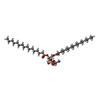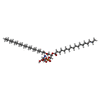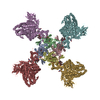+Search query
-Structure paper
| Title | Structure of an open K channel reveals tandem PIP binding sites mediating the Kir6.2 and SUR1 regulatory interface. |
|---|---|
| Journal, issue, pages | Nat Commun, Vol. 15, Issue 1, Page 2502, Year 2024 |
| Publish date | Mar 20, 2024 |
 Authors Authors | Camden M Driggers / Yi-Ying Kuo / Phillip Zhu / Assmaa ElSheikh / Show-Ling Shyng /   |
| PubMed Abstract | ATP-sensitive potassium (K) channels, composed of four pore-lining Kir6.2 subunits and four regulatory sulfonylurea receptor 1 (SUR1) subunits, control insulin secretion in pancreatic β-cells. K ...ATP-sensitive potassium (K) channels, composed of four pore-lining Kir6.2 subunits and four regulatory sulfonylurea receptor 1 (SUR1) subunits, control insulin secretion in pancreatic β-cells. K channel opening is stimulated by PIP and inhibited by ATP. Mutations that increase channel opening by PIP reduce ATP inhibition and cause neonatal diabetes. Although considerable evidence has implicated a role for PIP in K channel function, previously solved open-channel structures have lacked bound PIP, and mechanisms by which PIP regulates K channels remain unresolved. Here, we report the cryoEM structure of a K channel harboring the neonatal diabetes mutation Kir6.2-Q52R, in the open conformation, bound to amphipathic molecules consistent with natural C18:0/C20:4 long-chain PI(4,5)P at two adjacent binding sites between SUR1 and Kir6.2. The canonical PIP binding site is conserved among PIP-gated Kir channels. The non-canonical PIP binding site forms at the interface of Kir6.2 and SUR1. Functional studies demonstrate both binding sites determine channel activity. Kir6.2 pore opening is associated with a twist of the Kir6.2 cytoplasmic domain and a rotation of the N-terminal transmembrane domain of SUR1, which widens the inhibitory ATP binding pocket to disfavor ATP binding. The open conformation is particularly stabilized by the Kir6.2-Q52R residue through cation-π bonding with SUR1-W51. Together, these results uncover the cooperation between SUR1 and Kir6.2 in PIP binding and gating, explain the antagonistic regulation of K channels by PIP and ATP, and provide a putative mechanism by which Kir6.2-Q52R stabilizes an open channel to cause neonatal diabetes. |
 External links External links |  Nat Commun / Nat Commun /  PubMed:38509107 / PubMed:38509107 /  PubMed Central PubMed Central |
| Methods | EM (single particle) |
| Resolution | 2.9 - 6.9 Å |
| Structure data | EMDB-41277, PDB-8ti1: EMDB-41278, PDB-8ti2:  EMDB-43766: Kir6.2-Q52R/SUR1 apo closed channel |
| Chemicals |  ChemComp-PT5:  ChemComp-K:  ChemComp-PEF:  ChemComp-P5S:  ChemComp-NAG:  ChemComp-HOH: |
| Source |
|
 Keywords Keywords | TRANSPORT PROTEIN / ATP-sensitive potassium channel / KATP channel / SUR1 / Kir6.2-Q52R / potassium transport / metabolic sensor / diabetes / phospholipid binding / PIP2 |
 Movie
Movie Controller
Controller Structure viewers
Structure viewers About Yorodumi Papers
About Yorodumi Papers








